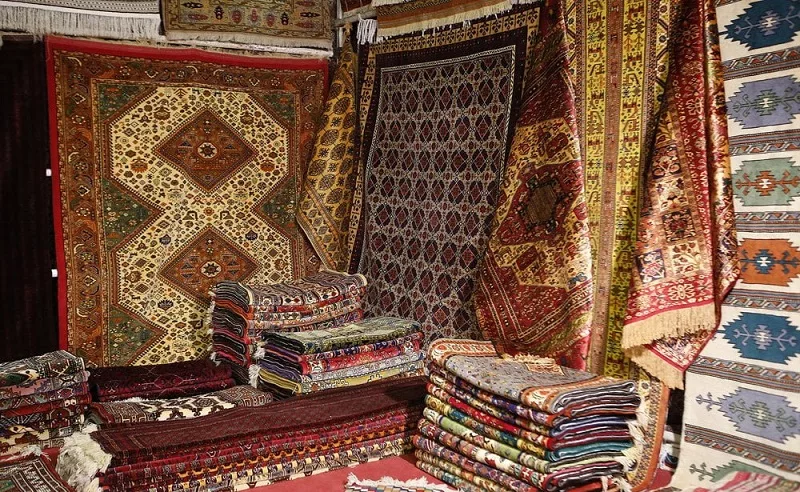
Hand-woven carpets are one of the most valuable and important products of Iran, with many fans worldwide. Most tourists who visit Iran choose an Iranian carpet as the main souvenir of their trip. However, knowing some basic tips is essential for buying an authentic and beautiful Persian carpet. In this article, we will guide you in this regard to make sure you know how to buy a Persian carpet during your travel or tour to Iran.
Types of Iranian Carpets
First of all, it’s good to know that Iranian carpets come in various types and are categorized based on design and pattern, material, size, type, knot density, and other factors.
Persian carpets are divided into the following types based on design:
The designs are categorized into Shah Abbasi, Islamic, Afshan, Botteh Jegheh, Hunting Grounds, Qabi, Geometric, Mihrabi, Vase, Turkmen and Bukhara, Gol Farang, Mahi Darham, Moharramat, Tribal and Nomadic, Historical Monuments and Islamic Buildings, Adapted, and also Combined designs, with some having further subcategories.
Based on material, Iranian carpets are categorized into the following types:
– All-wool hand-woven carpets
– Wool-warp carpets
– All-silk carpets
– Silk-flowered carpets
– Silk-based carpets
– Souf carpets
Persian carpets also vary in size and are classified as follows:
Rug: Refers to carpets with dimensions of 3×2 meters, 3.5×2.5 meters, 4×3 meters, and 4×6 meters.
Carpet: Refers to carpets with an area of less than four square meters. This category includes prayer rugs, two-zar’ee carpets, and curtain carpets.
Kellegi: Refers to carpets that are narrower than rugs and less than four meters in length.
Kenareh: A type of carpet with a width ranging from half a meter to 1.70 meters and a length from three to ten meters.
Zar’ and Nim: Includes carpets measuring 1.5 by 1.40 meters and 1.60 by 1.10 meters.
Zar’ and Chaharok: Refers to carpets with dimensions of 1.30 by 0.80 meters.
Poshti: Refers to small carpets with an area of less than one square meter.
Doormat: Includes small carpets suitable for placing in building entryways.
Pictorial Carpet: Includes small framed carpets hung on walls, featuring diverse and beautiful designs for home decoration and various settings.
Carpets are also classified based on the type of knot into two categories: Turkish knot hand-woven carpets and Persian knot hand-woven carpets. These knots may also be referred to as symmetrical knots, asymmetrical knots, and double knots.
Which city produces the best carpets?
Since ancient times, exquisite and beautiful carpets have been designed and woven by skilled artists in many regions of the vast land of Iran. This authentic Iranian art is renowned worldwide. The most famous cities in this artistic field are Tabriz, Kashan, Kerman, Mashhad, Naein, Hamedan, Malayer, and Qom. The quality of carpets from these areas is widely recognized, and each has its own distinctive features.
How to Recognize an Iranian Carpet?
Authentic Iranian carpets are woven only in Iran, and carpets produced in other places cannot compare to genuine Iranian ones. Authentic Persian carpets are hand-woven with delicate and special knots, offering very high quality and durability. The shine of an Iranian carpet, whether viewed from a distance or up close, is extremely beautiful and captivating, drawing the viewer’s eye. The unique visual appeal of hand-woven Persian carpets comes from their designs, patterns, and diverse colors, which bring mental and emotional tranquility.
Interestingly, hand-woven Iranian carpets stay cool in summer and warm in winter because they are made from natural, high-quality fibers. Therefore, authentic hand-woven Persian carpets never cause allergies. Additionally, high-quality hand-woven carpets prevent static electricity, contributing to better health.
Original hand-woven Persian carpets are produced in three main styles: Toranj, Kheshti, and Afshan, with the Lachak Toranj design being very popular among Iranians. This design features wide borders and oval or circular patterns in the center, inspired by Parthian architecture.
It’s worth noting that the more a hand-woven Iranian carpet is walked on, the more beautiful and valuable it becomes.
Method for Assessing Carpet Quality
When selecting a hand-woven Iranian carpet, you need to assess its quality from various aspects, including design, dimensions, color, pile, density, and signs of wear.
Design: The symmetry of designs and shapes is important. Ensure the carpet’s design is complete and not unfinished or incomplete.
Dimensions: The dimensions at the top and bottom of a hand-woven carpet are usually not identical, often differing by a few centimeters. A difference of up to three centimeters is considered normal, but larger discrepancies reduce the carpet’s value.
Color: Hand-woven carpets may have slight color variations when viewed in natural light. Ensure the color is uniform throughout the carpet. Note that the pile’s direction can make the color appear slightly darker, which is normal.
Pile: Examine the pile carefully. If the pile color differs between the surface and depth, it might be dyed with ink-based colors that can bleed. The pile should be shiny, durable, and flexible. Thicker pile carpets are more durable, attract less dust, and are easier to clean. Check for uniform pile height, as uneven piles indicate poor shearing.
Weave: Check the back of the carpet for a clearer assessment of quality. Count the knots per unit area to gauge the carpet’s density. Typically, the density is higher at the bottom of hand-woven carpets.
Signs of Wear: Inspect the carpet for signs of wear by looking at the back and examining the weave. Worn or repaired areas will feel rougher and stiffer, and you might see repair needle marks with close inspection.
Price of Persian Carpets
As explained, Persian carpets come in various types, and each is priced based on its characteristics. Factors such as the carpet’s size, the materials used in its weave, and its density play key roles in determining its price. To give you a general idea of the cost of hand-woven Persian carpets, here are the approximate prices for some popular types:
Wool Carpets (1.5 * 2 meters): Approximately 15-30 million Tomans (about $300 to $600).
Wool Carpets (4 square meters): Approximately 20-40 million Tomans (about $400 to $800).
Wool Carpets (6 square meters): Approximately 40-100 million Tomans (about $800 to $2000).
Silk-Flowered and All-Silk Carpets (2 * 1.5 meters): Approximately 100-300 million Tomans (about $2000 to $6000).
Keep in mind that the prices mentioned are approximately the minimum and are provided just to give you an idea. Carpet prices vary greatly based on the mentioned factors and, in some cases, the price of exquisite carpets can reach amounts such as $20,000 to $30,000.
Valuing an authentic hand-woven Iranian carpet is generally not straightforward, and it is advisable to seek advice from professional experts. Experienced experts can accurately determine the carpet’s value and price by considering various factors such as age, weave, design, color, size, knot count and density, and materials used. Many carpet specifications are also available on a label attached to the back of the carpet, providing you with essential information about the carpet’s identity.
Where to Buy Persian Carpets
To buy hand-woven Iranian carpets in person, you should visit the Grand Bazaar in Tehran, which is a hub for diverse and authentic Persian carpets. The Grand Carpet Bazaar is located on 15 Khordad Street in Tehran and is a beautiful, historic, and very large traditional market. Shops in the Grand Bazaar often offer a wide variety and large quantities of carpets for buyers.
In addition to Tehran, every city known for its carpet-weaving art has bustling traditional carpet markets. Cities like Isfahan, Kashan, and Tabriz have their own traditional carpet markets where you can easily find carpets woven in these cities and nearby areas.
Besides the Grand Bazaar in Tehran and the traditional markets in other cities, there are also various shops in different parts of the cities that specialize in selling hand-woven Iranian carpets.
How to Buy Persian Carpets Online
With a little internet search, you can find stores that sell hand-woven Iranian carpets. Remember to choose stores that have the Iranian e-commerce trust symbol (E-namad) if you want to buy online. These stores usually offer more than a thousand hand-woven carpets with various designs and patterns, allowing you to easily order the design you want.
You can also search on Instagram and Facebook to find small stores that sell hand-woven Persian carpets. These stores often have a good variety of different carpets, and you can see samples on their pages. Here are some stores you can check out:
How to Buy an Iranian Carpet Outside of Iran
In addition to the many stores in Iran where you can buy carpets, there are also numerous Iranian and non-Iranian sellers of hand-woven Persian carpets in most countries. Typically, you can find several stores in each country. If you wish to buy a hand-woven Iranian carpet in your own country, you will likely find a store with a little online searching. Iranian carpet stores are relatively common in countries such as the UK, the USA, and the Gulf countries, including the UAE, Oman, and Kuwait.
Here are some of these stores:
Thamescarpets in London
1800getarug in the USA
TopPersianRug in Kuwait
The Handmade Rug in Oman
How Can a Local Guide Help You?
Gathering comprehensive information before traveling to Iran to buy a carpet is very helpful, but you should know that many Iranians, especially in the markets, are not fluent in English. If you are not familiar with Persian, communicating with them can be challenging. Additionally, finding your way around, the difficulty of using public transportation in Iran, heavy traffic in downtown areas and routes to the markets, and searching for carpet shops can be tough. Moreover, carpets are relatively expensive, and considering the low value of Iranian currency, converting dollars or euros to Iranian Rials and calculating costs can be quite difficult for you. In such situations, seeking help from local guides is very beneficial. They can not only provide you with additional information but also facilitate communication with market vendors. With their knowledge of the routes, they can save you travel time.
To find a suitable tour guide, you can visit the Iran tourist guides page, send messages to the guides, ask your questions, and, if needed, ensure their assistance during your travel dates.
Top Iranian Local Tour Operators
Conclusion
Buying a Persian carpet in Iran is a unique and rewarding experience, allowing you to bring home a piece of exquisite craftsmanship. Whether you choose to explore the bustling Grand Bazaar in Tehran, visit traditional markets in cities like Isfahan, Kashan, and Tabriz, or shop online from trusted stores, knowing what to look for will help you make an informed decision. Assessing the carpet’s design, dimensions, color, pile, density, and condition ensures you invest in a high-quality piece. Remember to seek expert advice if needed and to verify the authenticity of online stores. With these tips, you can confidently select a beautiful and authentic Persian carpet that will add elegance and cultural richness to your home.

Leave a Reply